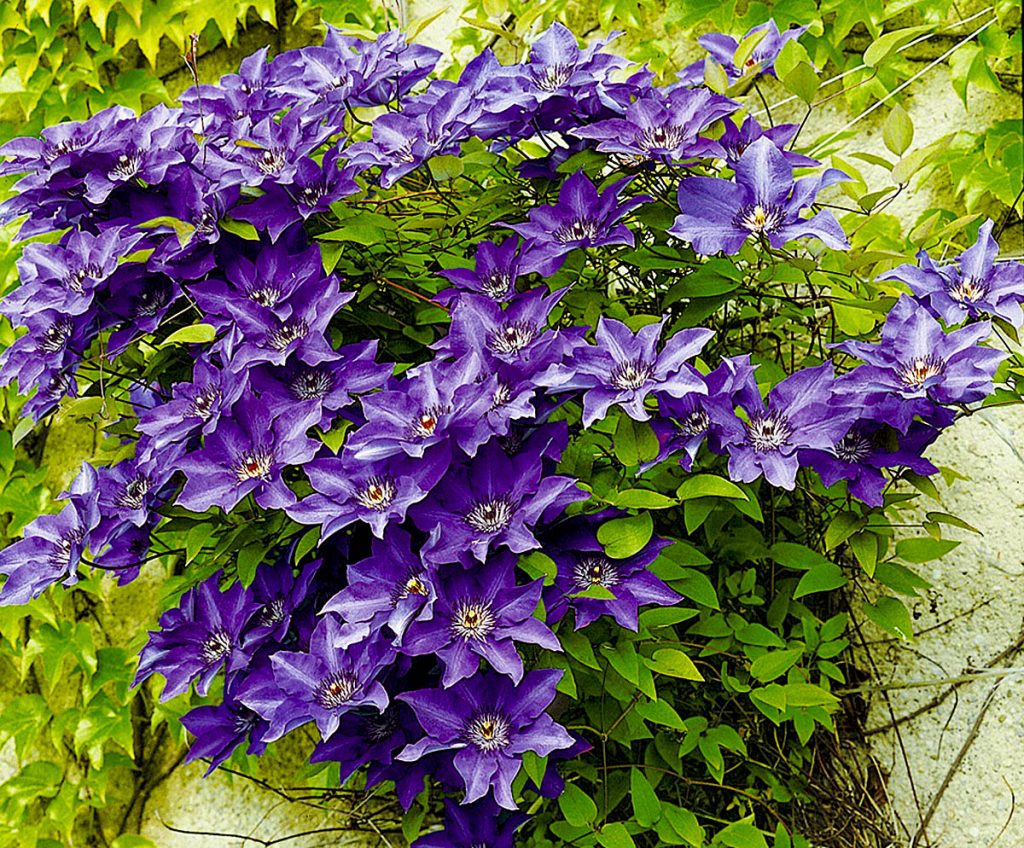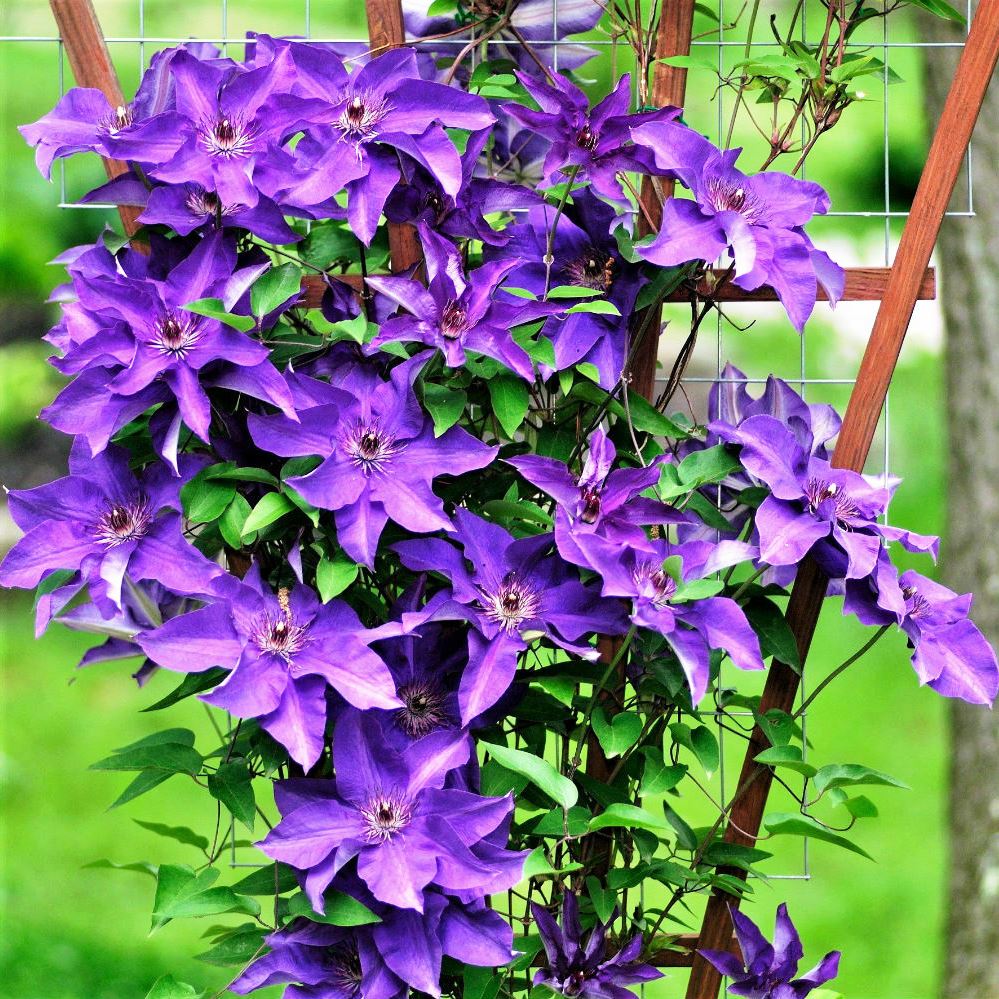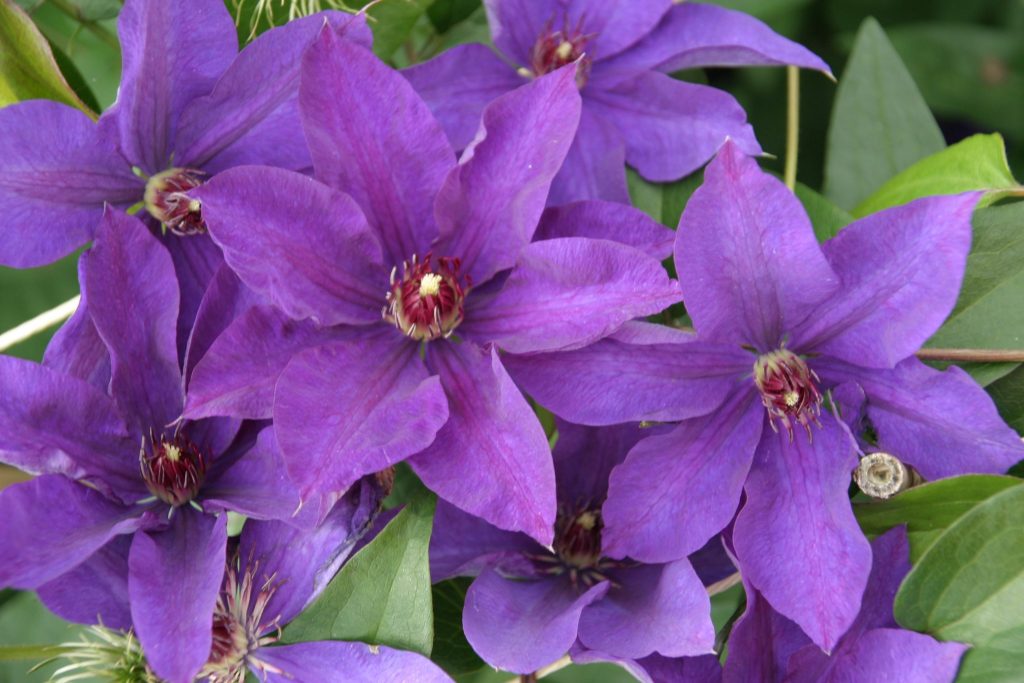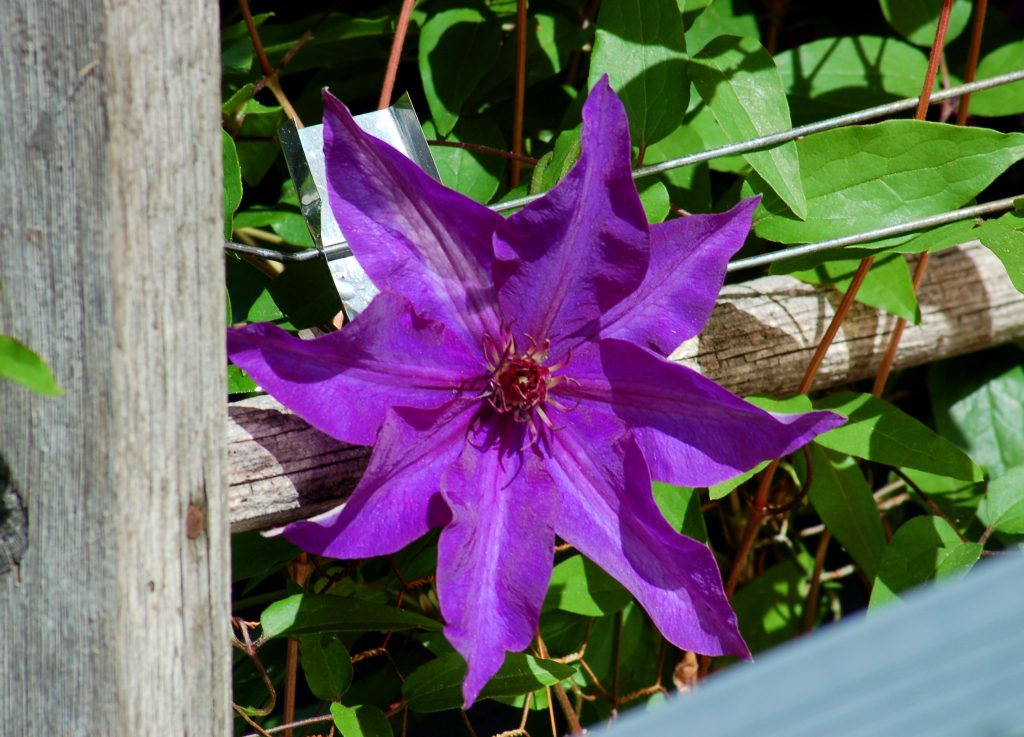Clematis President - planting and leaving
The bright-blooming perennial clematis President belongs to the Buttercup family. The variety was first discovered in the 16th century. This name was given in honor of the president of the British Royal Horticultural Society. He came to Russia in the 19th century and became very popular in private gardening. Consider its characteristics, planting and care rules.
- Description of the variety
- Landing rules
- Seat selection
- Preparation of planting material
- Landing technique
- Care
- Watering
- Loosening and mulching
- Top dressing
- Pruning and garter
- Preparing for winter
- Reproduction methods
- Cuttings
- Stem layering
- By dividing the root
- Diseases and pests
- Application in landscape
- Testimonials
- Useful videos

Clematis president
Description of the variety
People call this plant a vine or clematis. The scientific name is clematis President. Belongs to the group of large-flowered varieties.
Liana is deciduous, the length of the shoots varies from 2 to 2.5 m. The stems are bright green, has an intense vigor - it stretches by 5-10 cm during the season; easily braid and climb any surface. Throughout the growing season, a young seedling forms from 1 to 5 new shoots.
Flowers bloom on the branches of the current and last year, so the bloom is twofold - from late May to mid-June, then from the second half of July to early September.
The buds are large (15 cm), star-shaped, with bright bracts. In one inflorescence, 8 petals develop, pointed at the tip. The color is violet-blue, and closer to the center it is a couple of tones lighter.
Anthers are dark red or purple. Leaves are oval, green, medium-sized (10-15 cm). The root system is powerful, well fixed in the soil and extends 1 m deep;
The lifespan of clematis is about 30 years, subject to all the rules of cultivation and care.
Landing rules
You can plant clematis at any time of the year, with the exception of winter. But, as practice shows, it is better to do this in the first half of September. Due to the high humidity and moderate outdoor temperatures, the vine will take root faster after planting.

Clematis the president
Seat selection
The flower prefers to grow in the open sun, while the stems and foliage do not burn. Choose an area protected from drafts and with a deep passage of groundwater - up to 2-2.5 m.
To avoid overheating of the root system, ground cover perennials should be planted nearby, which will serve as a good shade.
You should not plant bushes near the walls of a house or outbuilding, because water flowing from the roof will fall on the crown and can provoke its rotting.
The soil is suitable for fertile, light, loose with a neutral level of acidity and low alkali content. You can plant a flower on loam or sandy loam. Growing on heavy and waterlogged soils is not recommended.
Preparation of planting material
You can buy seedlings in one of the specialized nurseries. They are usually sold in containers or pots.
When buying, inspect the crown - the stems, leaves, buds should be fresh, of a saturated solid color without cracks, growths, holes and fractures, which indicate the presence of sores or pests.
It is important to check the condition of the roots - they are well developed, the optimal length is about 30 cm. Healthy specimens have no mold, acidification and rot on the surface of the roots. If you find signs of disease, all spoiled places need to be cut off and the root system is treated with copper sulfate.
Immediately before planting, the roots are soaked for an hour in warm water.
Landing technique
Garden debris, weeds are removed on the site, dug up, leveled.

Clematis President Description
Then a landing pit is prepared - the approximate parameters are 60x100 cm. A thick layer of drainage is laid on the bottom - broken slate, brick chips, stones or crushed stone. Then, up to half of the volume, a fertile mixture of humus, dug earth and peat is poured (1: 1: 1). If the soil is poor, additionally add 100 g of superphosphate and potassium nitrate, 0.5 kg of wood ash.
If deoxidation is necessary, add a little dolomite flour or slaked lime.
All components are laid a month before the planned planting - this way the soil will compact and settle. A long and thick peg is driven into the hole, which will later serve as a support for the bushy vine.
The roots are lowered, straightened, covered with the remaining soil mixture, compacted, watered with settled warm water, mulched with peat. Tie the bush to the support.
The lowest bud should be deepened into the ground by 10-12 cm, so that in the future the plant will bush well. For group planting, a distance of at least 1.5 m between seedlings should be maintained, and 1.2 m in a row.
Care
This is an unassuming plant that requires standard care and maintenance.
Watering
Regular and abundant watering in the first months after planting will provide the seedlings with quick survival and rooting.
Frequency during the growing season - once a week. If the summer is too hot and dry, then water it every three days. Moisten directly under the root to avoid water getting on the stems and leaves. Moisture can cause them to rot.
Use settled, warm water. Consumption per bush in the first year of life - 20 liters. In the future, the dose is increased to 30-40 liters.
Loosening and mulching
After moistening, the soil is loosened to increase its moisture and breathability. It is also necessary to periodically weed the aisles, remove weeds, which take away moisture and nutrients from young plantations.

Clematis the president
Loose soil is mulched - sprinkle the trunk circle with peat or last year's manure (compost).
Top dressing
Starting from three years old, the decorative liana is fed several times per season every year. Mineral and organic compounds are introduced alternately. In early spring, watered with mullein solution (1:10). Consumption per bush - 5 liters.
A couple of weeks before flowering, they are fed with superphosphate and potassium sulfate - 15 g per bucket of water.
In the fall, when the plant fades and sheds foliage, last year's manure or compost is placed in the near-trunk zone.
After each meal, the vine is watered abundantly, which helps it absorb nutrients faster.
Pruning and garter
Regular trimming is one of the most important farming practices for this variety. This plant belongs to the 2nd group of pruning, which is carried out in two passes.
In the summer, after the end of flowering, the shoots of the last year are cut to the ground. Then, in the fall, 3 weeks before frost, the branches of the current season are cut to the lower bud in order to stimulate the appearance of new shoots next year.
In the first year of development, gardeners are advised to pick off the inflorescences on the seedlings so that they put in the strength and energy to build the crown and root system.
Additionally, throughout the growing season, cut off non-viable parts that have dried out, rotted, broken off.
The garter is carried out in the spring - the branches are directed in the right direction, tying them to a support (arch, trellis, fence or other structure).
Preparing for winter
Despite the good resistance to frost, young bushes are covered after a cardinal haircut.
The cut stumps are covered with a thick layer of peat, then covered with spruce branches or sprinkled with fallen leaves.
The insulation material is removed in the spring, when the snow melts and the last frosts pass.
Reproduction methods
Cuttings
Slicing is carried out in the spring or summer. The apices are taken from the stems of the current year. Each stalk should have several leaves and buds. At the bottom, the leaves are removed, dipped for half an hour in one of the growth stimulants, then planted in a wet mixture of peat and sand (1: 1). Embedding depth - 3-4 cm.

Clematis president photo and description of the variety
For quick rooting, the shoots are covered with a transparent cap, placed in a warm place with diffused light. Every day, the seedlings are ventilated, moistened with warm water as necessary.
After about 3-4 weeks, they will release roots - you can determine this by the new leaves. Then the shelter is removed, they grow for another month. In the first decade of September, they are transplanted into open ground.
Stem layering
Such reproduction is carried out in early autumn. Choose the most flexible and longest branch of the past year, which is closest to the ground. Remove all the leaves on it, lower it horizontally into a groove to a depth of 4-5 cm. Sprinkle with a mixture of peat, sand and humus (1: 1: 1), moisten.
Before the onset of persistent cold weather, cover with fallen leaves, then with a thick layer of peat.
In the spring, when the snow melts, the above zero temperature stabilizes, the branch is dug up, cut off from the mother bush. Divide into several parts so that each one has roots with kidneys. Places of cuts are irrigated with a solution of copper sulfate. After the roots dry, the seedlings are planted on the site.
By dividing the root
Old bushes that need rejuvenation are watered abundantly, then carefully dug out so as not to damage the root system.
The remains of the soil are washed off, divided into parts. Each delenka should have one shoot with buds and leaves, and 2-3 roots. The blanks are seated according to the same principle as purchased plants.
Diseases and pests
At all stages of growth, clematis can be damaged by various infections and parasites. The main reason is violation of the rules of planting and further care:

Clematis President Reviews
- Wilt. This is one of the most dangerous diseases that causes wilting of the entire crown. The leaves lose their turgor, dry and fall off. At the first signs of damage, you need to remove the damaged areas, then irrigate three times with an interval of 5 days with Fundazol. If the plant is running, it is dug up, burned, the hole is spilled with a solution of copper sulfate. To avoid infection, carry out preventive treatment with Fundazol in early spring and late autumn after leaf fall.
- Gray rot. This disease can be recognized by brown spots on the surface of leaves and stems. It is necessary to remove the infected organs, then treat with Fundazol or Azocene.
- Powdery mildew. Signs of infection are the appearance of a white bloom all over the crown. Over time, these parts darken, die off. Treatment is carried out as follows - all non-viable organs are removed, then sprayed with Topaz, Azocene or Fundazol.
- Rust. It manifests itself in the form of reddish or brown growths on foliage, shoots, buds. Bordeaux liquid will help to cope with a fungal infection. Dispose of all diseased areas before processing.
- Nematode. This insect damages the root system and causes necrosis of the aerial part. It is not subject to treatment, so clematis is dug up, burned. The pit is spilled with a fungicide - copper sulfate or Bordeaux liquid.
- Spider mite, aphid. Juice-sucking pests settle on the underside of leaves. They provoke their curling, yellowing, drying out and falling off. In the fight against these parasites, insecticides will help - Match, Aktara or Actellik.
- For rodents, they use various traps or poison, which are sold in specialized stores.
To avoid infection with sores or harmful insects, flower growers are advised to follow a number of simple preventive measures:
- buy healthy seedlings;
- before planting, carry out a deep digging so that, under the influence of the sun, all parasites and infectious agents that have got outside die;
- water, feed and loosen the soil regularly;
- remove weeds in time, inspect for the presence of diseases and pests;
- irrigate the crown in early spring and autumn after foliage has fallen with insecticides and fungicides.
Application in landscape
The large-flowered variety of clematis President has a dense, weaving crown, therefore it is ideal for vertical gardening:

Clematis president boarding and leaving
- near gazebos, arches, trellises, terraces;
- many plant it to create a beautiful decoration on the balcony, which additionally creates shading;
- A winding and flowering bush hanging from a fence or other structure looks beautiful.
Testimonials
Due to its high decorativeness, this culture has won the hearts of many flower growers:
- subject to all the rules of pruning, it grows quickly, which allows you to create a lush and bright decoration in any corner of the garden in a few years;
- an adult liana is not afraid of frost, therefore, it is suitable for cultivation in all zones of our country;
- with good care, there are no health problems and there is no need to fight parasites, sores.

